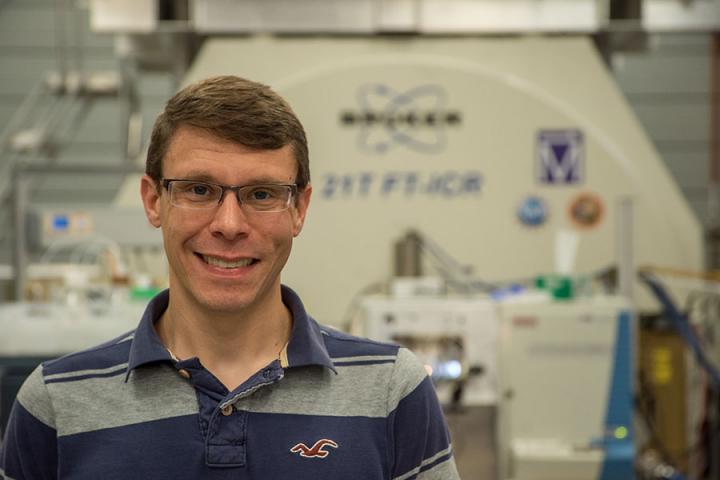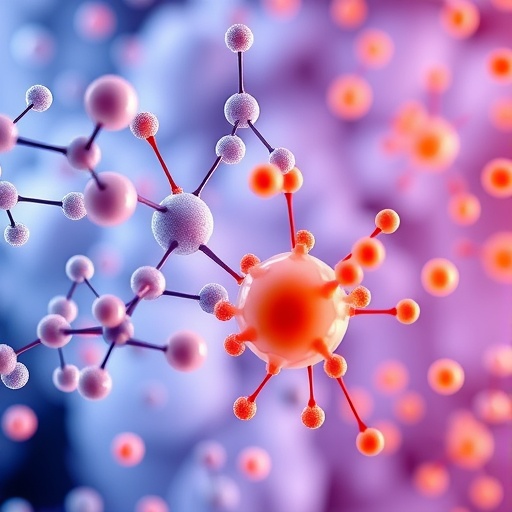
Credit: Stephen Bilenky
We’ve all heard, and seen, how a picture paints a thousand words. Now, in a scientific twist on that saying, researchers at the Florida State University-headquartered National High Magnetic Field Laboratory (National MagLab), are creating pictures that paint thousands of molecules.
Using a uniquely powerful instrument, the scientists have refined a technique called mass spectrometry imaging (MSI) that translates reams of data into detailed visuals of the molecular makeup of biological samples. Their work, published this week in Analytical Chemistry, features images with mass resolution so high that every color in the image represents a distinct kind of molecule.
MSI is not new. For years, scientists have used the technique to convert mass spectrometry analyses of a sample’s chemical makeup into spatial representations showing which molecules occur where.
What is different now, explained National MagLab chemist Don Smith, corresponding author on the study, is the breadth and depth of the data generated with the lab’s world-record 21-tesla ion cyclotron resonance (ICR) mass spectrometer, called the “21-T” for short. Tesla is a unit of magnetic field strength; a fridge magnet has a field of about 0.01 tesla and a typical hospital MRI magnet has a field of 2 or 3 teslas.
The 21-T enables mass spectrometry images to become ultra-high definition, with many more pixels making up the image.
“I like to think of this as the most information per pixel — how much chemical information we can get from each pixel in a given amount of time,” Smith said. “We are observing new molecules that have never been observed, never been mass resolved in tissue before.”
Last year, Smith teamed up with Ron Heeren from the Maastricht MultiModal Molecular Imaging Institute at Maastricht University in the Netherlands. With their team, the scientists ran a month’s worth of experiments in the 21-T, examining brain tissue from healthy rats. In each 24-hour experiment, they focused on specific biomolecules. In the two data sets examined for the Analytical Chemistry article, the team looked for certain lipids, a class of biomolecules that execute critical functions in the body, including in cell membranes.
Mass spectrometers are fancy molecular scales that use a strong magnet to identify each molecule in a substance by its unique mass. The molecules must first be given a positive or negative charge (ionized) so that the magnet can detect them. The team used a technique called matrix-assisted laser desorption ionization (or MALDI), used for the first time on the 21-T for this project with a special instrument shipped from Maastricht to Tallahassee. With this setup, they were able to methodically vaporize, ionize and measure one hair’s-width of tissue at a time, each containing thousands of molecules. In this way, bit by bit, they amassed measurements that special software converted into an MRI-like map of the molecules’ spatial distribution.
“It worked right away,” said Smith of the experiments. “That was a very pleasant surprise.”
The 21-T, acquired by the National MagLab in 2014 with funding from the National Science Foundation’s Division of Chemistry, proved an amazingly sensitive scale. Smith noted that scientists were able to separate two molecules with a difference in molecular weight of about three electrons — about .00179 daltons (the unit of molecular mass) or just a tiny fraction of the weight of a water molecule.
“This is the reason we come to the MagLab,” Heeren said, “to push imaging boundaries and see molecular detail that would otherwise remain hidden.”
The 21-T has proven to be a remarkably versatile instrument, said Chris Hendrickson, director of the lab’s ICR facility and a co-author on the paper.
“The experiments it has enabled have run the gamut from medical biology to emerging environmental contaminants,” he said.
Smith said this technique could become a powerful tool for health research. Currently the 21-T is routinely used to examine the molecular makeup of, among other types of samples, complex proteins. Future MALDI experiments could reveal not just which molecules are in there, but precisely where in a tissue sample each is located.
Cancer researchers could use the technique to examine, on the molecular level, exactly where and how a drug travels through diseased tissue; another scientist could study how an organism responds to exposure to a pollutant. Researchers may even be able to compare examples of the same kind of cell to one another to detect subtle molecular differences.
As for Smith, he and his team have their work cut out for them, with plenty of data awaiting analysis.
“We basically tried a little bit of everything,” said Smith of last year’s experiments.
That’s two data sets down, 26 to go.
In addition to Smith, Heeren and Hendrickson, contributors to the article included Andrew Bowman (first author) and Shane Ellis of Maastricht University and National MagLab scientist Greg Blakney. The MALDI instrumentation used for the experiments was made available with support from the Dutch province of Limburg.
###
Media Contact
Kristin Roberts
[email protected]
850-644-1933
Original Source
https:/
Related Journal Article
http://dx.




